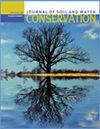Benefits, barriers, and use of cover crops in the western United States: Regional survey results
IF 2.6
4区 农林科学
Q2 ECOLOGY
引用次数: 0
Abstract
Cover crops provide known benefits to water, air, and soil quality. The western United States is a large cropping region where data on cover crop use are lacking. In this study, we draw on data from a 2020 survey of western farmers from 13 states and territories to broaden the understanding of current cover crop use and the factors that influence cover crop adoption. We examine cover crop use through farmer and farm characteristics, social networks and information access, and psychological measures of attitudes toward cover crops. Based on the results of the 894 survey responses, we find most respondents use or have used cover crops and recognize their many benefits. The highest ranked benefits of cover crops, according to cover crop users, are soil health benefits and reducing soil erosion. The biggest perceived barriers to cover crops, according to cover crop users and nonusers, are costs and knowledge. The greatest predictor of cover crop use in the western United States is larger farm size; however, as income increases, the odds of cover crop use decreases. Farmers who access agriculture-related information on a regular basis and western farmers who perceive more benefits than barriers to cover crops are more likely to use cover crops. This study informs future research, outreach, and policy through insight into motivations and barriers to cover crop use and factors that influence adoption for farmers in the West.美国西部覆盖作物的效益、障碍和使用:区域调查结果
覆盖作物对水、空气和土壤质量有众所周知的好处。美国西部是一个种植面积很大的地区,缺乏覆盖作物使用的数据。在这项研究中,我们利用了2020年对13个州和地区的西部农民的调查数据,以扩大对当前覆盖作物使用情况和影响覆盖作物采用的因素的理解。我们通过农民和农场特征、社会网络和信息获取以及对覆盖作物态度的心理测量来研究覆盖作物的使用情况。根据894份调查回复的结果,我们发现大多数受访者使用或已经使用覆盖作物,并认识到它们的许多好处。根据覆盖作物使用者的说法,覆盖作物的最高效益是土壤健康效益和减少土壤侵蚀。根据覆盖作物使用者和非使用者的说法,种植覆盖作物最大的障碍是成本和知识。美国西部覆盖作物使用的最大预测指标是较大的农场规模;然而,随着收入的增加,覆盖作物的使用几率降低。定期获取农业相关信息的农民和认为覆盖作物的好处大于障碍的西方农民更有可能使用覆盖作物。本研究通过洞察覆盖作物使用的动机和障碍以及影响西方农民采用的因素,为未来的研究、推广和政策提供信息。
本文章由计算机程序翻译,如有差异,请以英文原文为准。
求助全文
约1分钟内获得全文
求助全文
来源期刊
CiteScore
4.10
自引率
2.60%
发文量
0
审稿时长
3.3 months
期刊介绍:
The Journal of Soil and Water Conservation (JSWC) is a multidisciplinary journal of natural resource conservation research, practice, policy, and perspectives. The journal has two sections: the A Section containing various departments and features, and the Research Section containing peer-reviewed research papers.

 求助内容:
求助内容: 应助结果提醒方式:
应助结果提醒方式:


